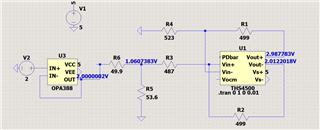Hi,
The THS4500 datasheet's fully differential amplifier configuration assumes a 50 Ohm source impedance. However, in the presence of the 50ohm source impedance, the gain is affected by a factor of 1/2. In this circuit, I expect an output voltage Vout+ - Vout- = 2V but I see 1V. When I bypass the 50Ohm resistor after the buffer stage (R6), the circuit works fine. Mathematically this makes sense to me but seems strange that the datasheet says otherwise. 

